| From: Ropelie
|
|
|
|
|
|
|
| Date: 22-Apr-18 |
|
To say I am blessed is an understatement. I was able to harvest some nice Osage logs from a property near me. Is splitting the big one's which are 14-16" diameter into bow staves the best use for these gorgeous logsmm at this point I am only interested in self bows.
|
|
| From: JusPassin
|
|
|

|
|
|
|
| Date: 22-Apr-18 |
|
Not sure what other use you are considering. By all means, if green split, seal the ends, and tuck away to season.
|
|
| From: Bowlim
|
|
|
|
|
|
|
| Date: 22-Apr-18 |
|
I have only harvested a few very small Osage pieces, not large enough for bows. The wood I got was gnarly. Does not look that easy to split, and piece 14-16" in diameter can be a bear in any wood. If you think it will split and is super straight grain, Awesome.
It is BS that you need to split wood to follow the grain, if you choose to saw it you just need to lay the cuts out to follow the grain and give yourself enough material so that when you get to teh hand tool you didn't cut through something you needed.
You should also consider that Osage is a rare and precious wood, and even if some pieces are not great for what you want, they will have a use for laminated bows, or guitars, pens, bowls, furniture, etc... A 4 foot log in board form, dried, 16 inches in diameter, with 100% yield (could be 3/4 or half that in reality), is worth $1141 at retail.
|
|
| From: Osage Outlaw
|
|
|
|
|
|
|
| Date: 22-Apr-18 |
|
Yes! Split those logs up and see what's inside.
|
|
| From: badger
|
|
|
|
|
|
|
| Date: 22-Apr-18 |
|
talk to some of the guys here who harvest osage before splitting so you can get the most out of it. I like to 1/4 the log and then take 4 splits out of the belly, Then split all the 1/4's again and if possible take another belly split off of them before splitting again. If everything went perfect and it never does you could get as many as 36 splits of that log.
|
|
| From: Ropelie
|
|
|
|
|
|
|
| Date: 22-Apr-18 |
|
Thanks for the insight. As it sits the two biggest logs one is 12 in in diameter and the other is 16 in diameter. Both in the middle of the log. When you say quarter the log do you mean Mill itinto quarters then split or split it into quarters with wedges. Right off the back
|
|
| From: Jim Davis
|
|
|
|
|
|
|
| Date: 22-Apr-18 |
|
Some logs that big are very gnarly and splits run off in spirals or tight corners. Might be better to saw it into quarters and look at the grain before going further.
|
|
| From: Jeff Durnell
|

|
|
|
|
|
|
| Date: 22-Apr-18 |
|
Split it into quarters with wedges. It's not that difficult, especially if it's relatively straight grained. I've done 2' logs myself.
After it's in quarters, decide whether you can take belly splits off. If so, do it, and keep splitting those quarter up until they're all 3 - 4" across the bark.
You have the ends sealed, right?
I like to sink the first wedges in the end cut of the log, on the smaller end.
Ewwww, I love splitting osage.
|
|
| From: Ropelie
|
|
|
|
|
|
|
| Date: 22-Apr-18 |
|
Thanks for the advice jim
|
|
| From: hunterbob
|
|
|
|
|
|
|
| Date: 22-Apr-18 |
|
If the bark looks straight start splitting those logs.
|
|
| From: Ropelie
|
|
|
|
|
|
|
| Date: 22-Apr-18 |
|
For some reason I can't post pics. Yes the bark is nice and straight. I've split some Osage and hickory but nothing this large and wanted to touch base with some experience before I butcher these beauties!
So after I quarter is where I'm a little confused. Do I take a 2 inch wide split from the angled part of the quarter to the bark?
|
|
| From: Osage Outlaw
|
|
|
|
|
|
|
| Date: 22-Apr-18 |
|
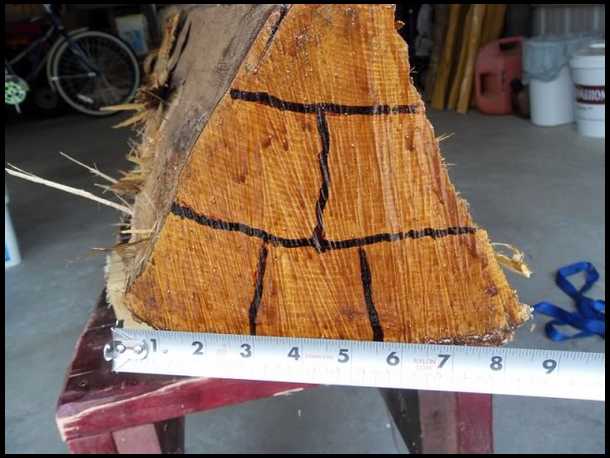
If the bark is straight there is no need to saw it. Split it in half and see what you have. If the two halves split somewhat straight go ahead and split each one in half again. Those are your quarter logs. Depending on the shape and thickness, you can get belly splits off of the quarters. Keep splitting the pieces in half until you get them down to bow stave size. If the grain is straight and clean enough you can split them into thirds if the piece is wide enough. Be careful. The splits can run towards one side. Sometimes it helps to look at your small end and draw where you think the staves are and try to split them out.
This was from a 24" tree.
|
|
|
|
| From: Osage Outlaw
|
|
|
|
|
|
|
| Date: 22-Apr-18 |
|
That piece split just where I wanted it to and I got 6 staves from it.
Remember to look at your small end first. That's where I like to start my splits. You don't need big sledge hammers to split osage. I do all of my splitting with a 4 lb and 3 lb mini sledge and I go through a lot of large diameter osage. Make sure to seal the ends with a few coats of glue, shellac, poly, wax, paint, etc. If you get any belly splits seal the backs of those staves like you did the ends. If you remove the bark, take the sapwood off with it and seal the exposed back. Wear eye and ear protection while splitting. It's loud and pieces of the wedge or hammer can chip off.
Good luck and please post some pictures of your progress if you can.
|
|
| From: Ropelie
|
|
|
|
|
|
|
| Date: 22-Apr-18 |
|
Great pics thanks for taking the time. I'll split these suckers up and post pics
|
|
| From: Bentstick54
|
|
|
|
|
|
|
| Date: 22-Apr-18 |
|
If you leave the bark on any of them, spray the bark down with an insecticide to keep the borers from tunneling into the wood.
|
|
| From: longbowguy
|
|
|
|
|
|
|
| Date: 23-Apr-18 |
|
Thanks guys. I will probably never get a chance to do it, but it is nice to know a bit about how. - lbg
|
|
| From: Stoner
|
|
|
|
|
|
|
| Date: 23-Apr-18 |
|
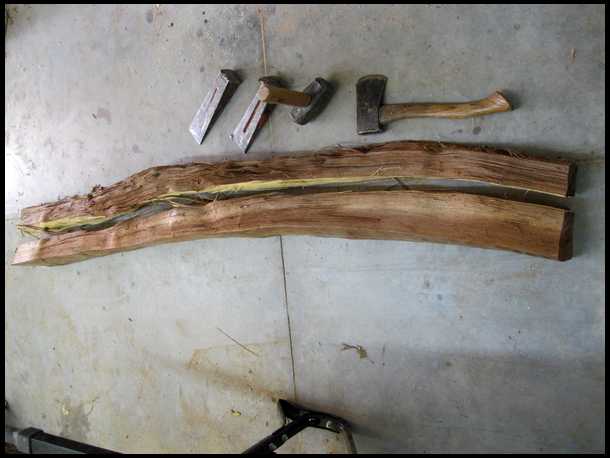
Had this fellow in the rafters since 2010. 18" diameter. Backset split core wedge. John
|
|
| From: Stoner
|
|
|
|
|
|
|
| Date: 23-Apr-18 |
|
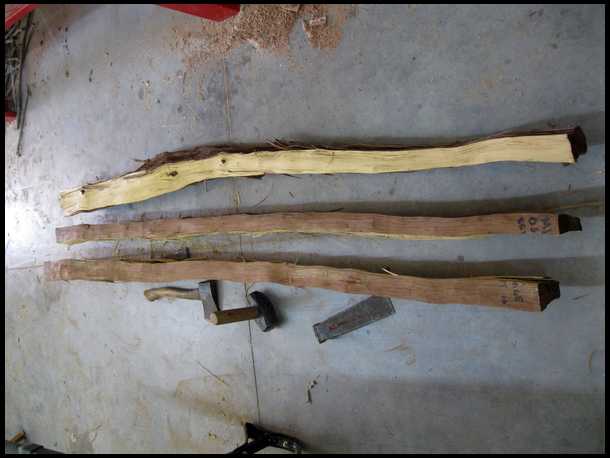
Split outside again and got 3 outta 1. John
|
|
| From: Eric Krewson
|
|
|
|
|
|
|
| Date: 23-Apr-18 |
|
If you are young, halve your log with wedges and a sledge and then follow the instructions above. If you get belly splits like Osage Outlaw seal the backs well.
Being and old guy and even when I wasn't; if I had a large trunk I would make my first cut with a chainsaw to halve the log and split the halves into staves with the traditional wedges and a sledge.
You will loose a little bit of wood with the chainsaw halving by not following the grain on your first split. I have had logs that would take over an hour to make that first split, I prefer 5 minutes and no sweat with a chainsaw.
|
|
| From: Germandogs
|
|
|
|
|
|
|
| Date: 23-Apr-18 |
|
How long does one need to let the logs Season? For osage and Hickory?
|
|
| From: Michael Schwister
|

|
|
|
|
|
|
| Date: 23-Apr-18 |
|
For osage I have had finished bows from standing trees in as short as three weeks (21 days) with a very accelerated force drying process. For Pignut (the only hickory worth making bows IMHO) one year at least under force drying process. To work that fast you need to stark roughing the stave down to a blank almost immediately upon felling the tree.
|
|
| From: Michael Schwister
|

|
|
|
|
|
|
| Date: 23-Apr-18 |
|
For osage I have had finished bows from standing trees in as short as three weeks (21 days) with a very accelerated force drying process. For Pignut (the only hickory worth making bows IMHO) one year at least under force drying process. To work that fast you need to stark roughing the stave down to a blank almost immediately upon felling the tree.
|
|
| From: Eric Krewson
|
|
|
|
|
|
|
| Date: 23-Apr-18 |
|
If you leave the osage in log form without splitting you could probably split it 5 years later and still have green wood in the center. You have to split it to get it dry enough to work into a bow.
|
|
| From: SGT Kaveman
|
|
|
|
|
|
|
| Date: 23-Apr-18 |
|
Osage is subject to attack from a wasp that lays eggs which develop into wood boring larvae. If possible, split into staves, remove the bark & sap wood, paint or seal the ends with hot wax & lay it up out of the weather for two years to dry out. The sealant allows the stave to dry slowly, preventing cracks.
Split as above, but I use a chainsaw to reduce large logs.
Osage is very rot resistant. I think it was 2004 MoJam, a retired Baptist preacher (talk about blessed!) (what was his name?) told us about putting a large Osage log into the ground as a corner post in1935... Then the dug it up in 2003 & made bows out of it.
|
|
| From: SGT Kaveman
|
|
|
|
|
|
|
| Date: 23-Apr-18 |
|
For faster drying & seasoning, a roughed out bow blank will season/dry within a few months, usually. Depending on humidity... If placed inside a heated space, etc. a green stave roughed out (say with a bandsaw) can be used much faster than other full size staves from the same tree as it will dry faster. Be sure to seal the ends well.
|
|
| From: Jeff Durnell
|

|
|
|
|
|
|
| Date: 23-Apr-18 |
|
Yep. I've done like Michael, from trees to bows in 3-4 weeks.
In order to make an osage bow in such a timely fashion, the log needs reduced to stave-splits right away. Take one stave and remove the bark and sapwood, seal the back, and get most of the excess wood removed. I like to make them 2" wide and 3/4" thick in the limbs, with extra meat for the handle and dips. Steaming and reflexing can be done early, and steaming wet, fresh cut wood actually helps drive moisture out.
That much could be done in the first couple of days.
|
|
| From: PEARL DRUMS
|
|
|
|
|
|
|
| Date: 23-Apr-18 |
|
I've rushed a few as well. The biggest risk are checks when you heat it up "green", be it steam or dry heat. Internal moisture heats up and expands. The pressure has to go somewhere so it opens up very narrow checks that can get quite long at times. They can occur on the back or belly, or both. You have to be careful and use good judgement.
|
|
| From: Jeff Durnell
|

|
|
|
|
|
|
| Date: 23-Apr-18 |
|
Yep, I agree. It's a risk.
|
|
| From: Michael Schwister
|

|
|
|
|
|
|
| Date: 24-Apr-18 |
|
Sidebar conversation ref: wasp larvae. Had them get into a big batch of staves one time. Asked Dean Torges what to do, he said drown the Bast&&ds! I filled my canoe with water and soaked my cured staves for two weeks. I got to it in time, and the larvae were only a couple rings down. Saved the whole pile.
|
|
| From: Jeff Durnell
|

|
|
|
|
|
|
| Date: 24-Apr-18 |
|
Hmmm. Interesting.
Only time I ever had canoes full of water was on/in lake :^(
|
|
| From: keepemsharp
|
|
|
|
|
|
|
| Date: 24-Apr-18 |
|
Have never split any Osage big logs but they make great corner posts, Will last 60 years if you plant them in dirt. Put them in concrete and they will rot right off.
|
|
| From: Ropelie
|
|
|
|
|
|
|
| Date: 24-Apr-18 |
|
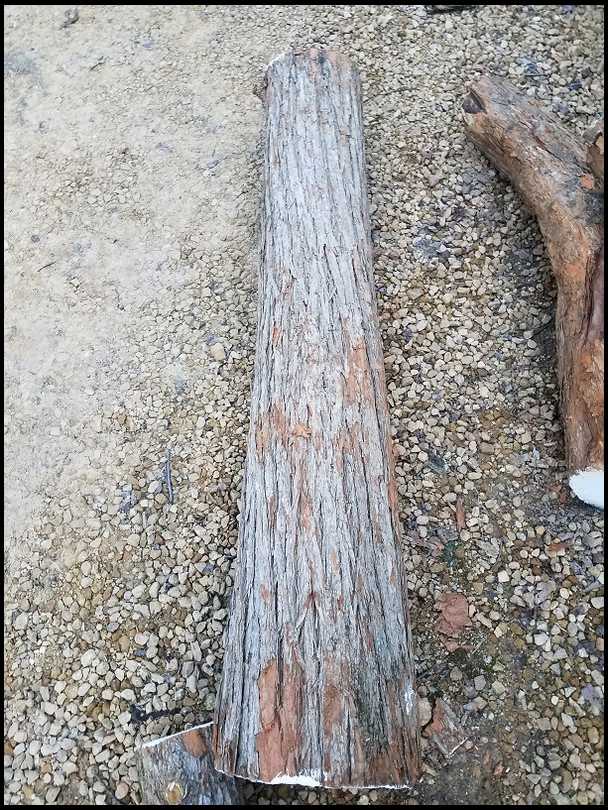
I got around to a computer and will post a few pics. Can I get some opinions on the grain pattern on this one? Looks crooked a little. I don't want to waste the log by splitting.
|
|
| From: Ropelie
|
|
|
|
|
|
|
| Date: 24-Apr-18 |
|
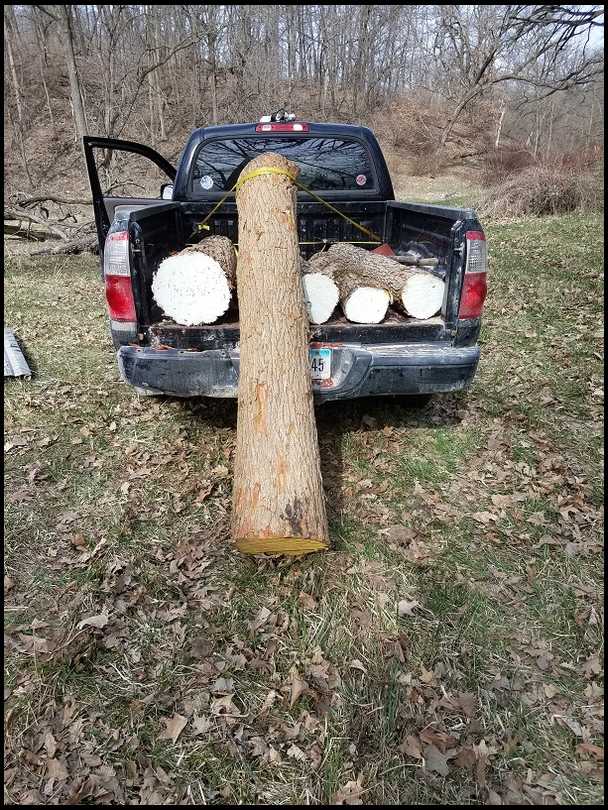
Here's another. Loaded by myself, my back hurts!
|
|
|
|
| From: badger
|
|
|
|
|
|
|
| Date: 24-Apr-18 |
|
That log weighs about 1,000 pounds. Remind me not to piss you off if we ever meet.
|
|
| From: Ropelie
|
|
|
|
|
|
|
| Date: 24-Apr-18 |
|
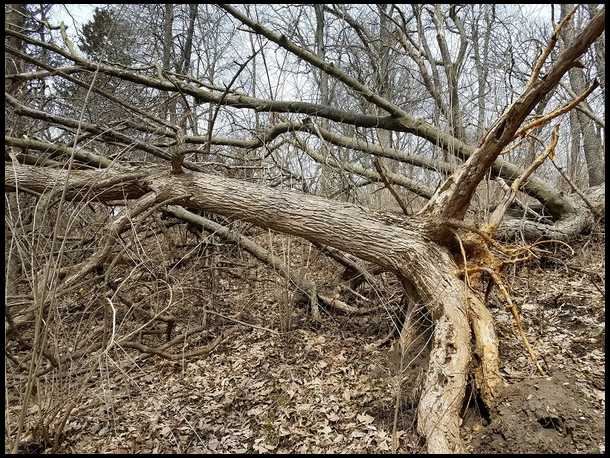
Same tree before I cut it
|
|
| From: Ropelie
|
|
|
|
|
|
|
| Date: 24-Apr-18 |
|
I tried lifting it again after I unloaded it with the tractor and couldn't budge it. The adrenaline of these logs definitely aided in the lifting!
|
|
| From: Jeff Durnell
|

|
|
|
|
|
|
| Date: 24-Apr-18 |
|
Yeah, the piece in the first picture has some serious twist. You can saw it straight on a mill, rip it with a chainsaw and then cut the halves up on a bandsaw, make boards for backed bows, or whatever, but you will be violating the grain in the process. The twist will always be 'in there', and may be an issue later, depending on what you use it for.
Some of the others look pretty nice.
Sometimes, rather than wrestle those big boys into the truck like that, I'll split em where they fall.
|
|
| From: Osage Outlaw
|
|
|
|
|
|
|
| Date: 24-Apr-18 |
|
Nice looking logs. I know what you mean about an adrenaline rush while cutting osage. I flipped a large log up out of a creek bed and over a row of bull dozed trees to get it to my truck. A few days later it was all I could do to pick one end up to move it.
|
|
| From: Arvin
|
|
|
|
|
|
|
| Date: 26-Apr-18 |
|
Out law that log with 9 staves in it in the above pic. You still have those staves? Pm me. Arvin
|
|
| From: Arvin
|
|
|
|
|
|
|
| Date: 26-Apr-18 |
|
Oh and by the way follow Osage outlaws instructions. If they won't split straight you can't saw the twist out! Been there done that. Arvin
|
|
| From: Arvin
|
|
|
|
|
|
|
| Date: 26-Apr-18 |
|
Oh and by the way follow Osage outlaws instructions. If they won't split straight you can't saw the twist out! Been there done that. Arvin
|
|
| From: Osage Outlaw
|
|
|
|
|
|
|
| Date: 26-Apr-18 |
|
Those staves are long gone Arvin. That was from a giant osage tree that I cut in 2011.
|
|
| From: Arvin
|
|
|
|
|
|
|
| Date: 26-Apr-18 |
|
I figured that! If you find another like thatet me know. Arvin
|
|
| From: hunterbob
|
|
|
|
|
|
|
| Date: 26-Apr-18 |
|
I would split everyone you have on the truck.
|
|
| From: Ropelie
|
|
|
|
|
|
|
| Date: 28-Apr-18 |
|
Sawing into boards and stickers and weighted they should dry flat right? Wouldn't splitting create some dramatic propeller twist?
|
|
| From: Arvin
|
|
|
|
|
|
|
| Date: 28-Apr-18 |
|
Not if it's Osage . The propeller is there or it's not. A good heat gun operator usually can fix that though. Arvin
|
|
| From: badger
|
|
|
|
|
|
|
| Date: 28-Apr-18 |
|
Ropelle, osage is very sensitive to following the grain, that's why it is always split. If you saw it straight it violates the grain lines, ( different from rings) The bow will likely break. Best to split and use heat to remove the twist.
|
|
| From: Ropelie
|
|
|
|
|
|
|
| Date: 28-Apr-18 |
|
Ok I'm on the same page. Bow staves are split and heat treated to straighten the propeller twist. I can mill it and use it for laminated backs or whatever else just not bows.
|
|
| From: Eric Krewson
|
|
|
|
|
|
|
| Date: 29-Apr-18 |
|
A log may be badly twisted on one end but have straight grain wood on the other end. If you have 36" of straight wood trunk you can make billets to splice in the handle to make untwisted, perfect staves. At least half of the bows I have made over time have been from spliced billets.
36" will work but I cut all my billets 40" long to give me some wiggle room for splicing them. The billets we call "sister" billets that are side by side in a log make the best bows because they are so closely matched in grain.
|
|
| From: Jeff Durnell
|

|
|
|
|
|
|
| Date: 29-Apr-18 |
|
That's a good point Eric. Twisted or otherwise junky halves of full length staves can be discarded and the good halves spliced together. It's better if they're sisters, but they don't have to be.
The picture of the first full log looks like a possible candidate for such treatment. The near half looks to have less twist than the far half.
|
|
If you have already registered, please sign in now
For new registrations Click Here
|
|
|
|



